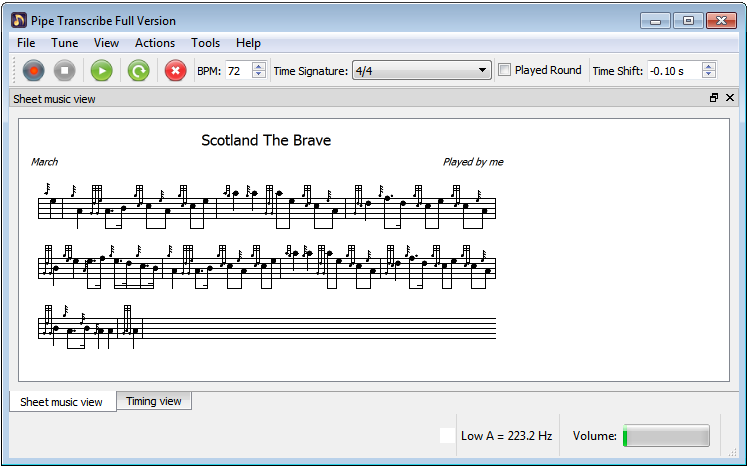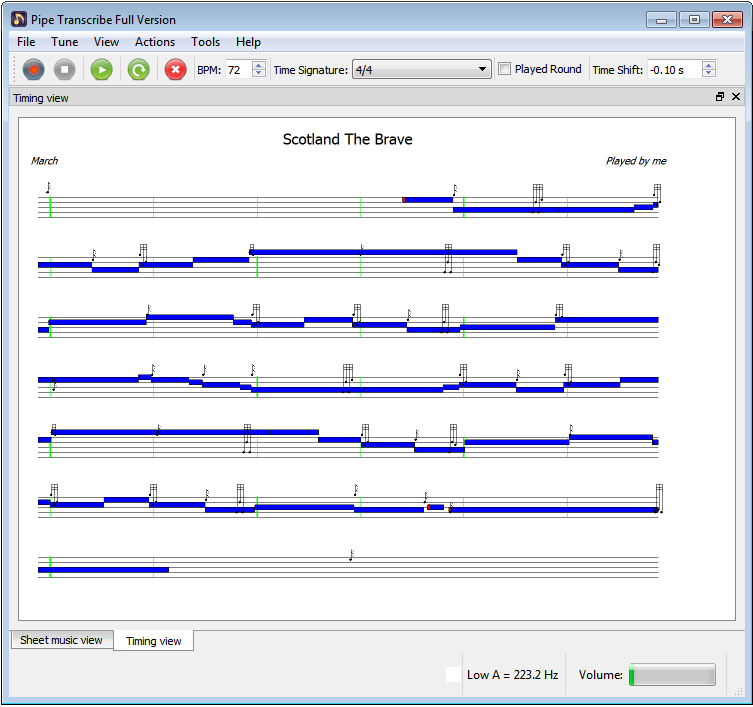Pipe Transcribe will automatically produce sheet music from recording you play the practice chanter.

Jump to:
Producing an accurate transcription will depend on the audio quality of your recording, how in time your playing is, and how distinct your ornamentation is played.
It is recommended to make short recordings of a phrase or single part of a tune, rather than trying to achieve an exact transcription of an entire tune in one recording.
While is it possible for a mid level player with a good audio setup to achieve an exact transcription, it will often be the case that there will be small differences, due to the playing, the recording, or limitations in the software.
To correct these differences and to produce a final score, we suggest saving in BWW format and opening the BWW file in one of the excellent pieces of Bagpipe Notation Software available on the market (see the Recommended Edition Software section).
In order to produce a good transcription of your playing, the audio recording must be of reasonable quality. Not so loud it is distorted (too loud can be worse than too quiet!), a consistent volume, and not too much background noise.
You can listen to the recording of your most recent recording by selecting ![]() Actions->Play Audio.
Actions->Play Audio.
As a rough guide you could set up as following:
If you have multiple audio input devices configured on your system, you can select which one to use from Tools->Settings->Audio
To hear the sort of recording quality required, open one of the examples and play the audio.
If you see a lot of extra gracenotes where there should be none, experiment with setting an Input Filter Frequency of around 2500 Hz in the Audio settings.
After creating a recording, you can set the Tune Name, Tune Type and Composer by selecting ![]() Tune->Tune Details
Tune->Tune Details
When you create a new recording, or when you exit the application, your current recording is automatically saved in Pipe Transcribe Files (.pta) format (see below), and can be reloaded at any time. Autosaved files are named with the date, time, and tune name at the time of saving.
By default, the last 100 autosaved files are kept (this value can be adjusted in the Application settings).
You can manually save your tune to the following formats by selecting the appropriate value in the Save As Type section in the Save As window:
Pipe Transcribe is able to detect the following grace notes and movements
Movements not listed above will be interpreted as single gracenotes or melody notes with varying degrees of success.
To be able to accurately transcribe the software needs to know the audio frequency of each note on your chanter. Practice chanters are often not perfectly in tune, and can vary depending on temperature and moisture, so it is essential to perform an initial calibration, and perhaps subsequent ones if you think the chanter has changed tone (or if transcription stops being so accurate).
The calibration process is quick and simple. From the main menu select ![]() Actions->Calibrate chanter note. You will have a few seconds to get
ready. During this countdown start to play Low G as steadily as you can.
Hold Low G until you see the notes detected go from 0 to 1 (The time
taken for this should be around a couple of seconds or so). Then play
Low A and wait for the notes detected to go from 1 to 2. Continue all
the way up the scale in this manner. Once you are finished, the
Calibration dialog should indicate success and close.
Actions->Calibrate chanter note. You will have a few seconds to get
ready. During this countdown start to play Low G as steadily as you can.
Hold Low G until you see the notes detected go from 0 to 1 (The time
taken for this should be around a couple of seconds or so). Then play
Low A and wait for the notes detected to go from 1 to 2. Continue all
the way up the scale in this manner. Once you are finished, the
Calibration dialog should indicate success and close.
As a rough guide, the detected value of your Low A will be shown in the bottom right of the screen. A normal practice chanter Low A will be around 220 Hz
If you wish, you can play the chanter notes in any order. If necessary, you can also take breaths between notes.
It is recommended to keep background noise to a minimum while calibrating.
During recording, the Pipe Transcribe software automatically track changes to the tuning of your chanter notes, but still uses the calibrated values as a guideline - so make sure the calibration is up to date.
The calibration values are automatically saved when you close the software, and automatically restored when you start it again.
Tip: When loading a PTA file the calibration from the PTA file is also loaded. So if you want to save and reload your normal practice chanter calibration, calibrate your chanter, make a brief recording (e.g. play a quick scale), then save as a PTA file. This file can then be loaded in the future to restore your calibration.
In the settings you are able to configure the countdown time. This countdown just gives you time to prepare after starting calibration, so you can set to whatever value suites you. As long as there is not too much background noise, you don't have to be playing when the countdown stops, so you even set this to 0 if you wish.
You are also able to configure the calibration note average duration. This affects how long you have to play each note for. You may find that you get perfectly good results for a shorter duration, and lowering this will enable you to calibrate even quicker. On the other hand, you may prefer to increase the value to try to get a more accurate calibration.
To be able to accurately transcribe you need to play in time to a certain speed. The metronome click is to help you achieve this.
To adjust the volume of the click use the main volume control on you PC. Ideally you want the click just loud enough to hear, but not so loud that it may interfere with the recording.
Depending on you speaker and microphone setup, it may be advisable to use headphones to hear the metronome click to avoid interference with the recording.
There can be a difference in timing between your normal computer time and the time as used to sample the audio. This can result in the metronome click timing varying slightly over time, enough to cause transcription problems.
This difference in timing is dependent on your computer hardware, and what other software and drivers you have installed. The Pipe Transcribe software tries to automatically compensate for this difference in timing by monitoring the difference and making small adjustments to the interval of the metronome click to keep it having the same time period as the audio sampling.
In the settings, you can configure the maximium adjustment that will be made to the metronome interval. Setting this value to 0 will disable the automatic compensation.

In the Timing view, each line corresponds to 5 seconds. The melody notes are drawn as blue bands whose lengths represent the length in seconds of the note. The green lines represent the beat, with the heavier green lines indicating the start of a bar.
This view allows you to see the exact timing, and as well as allowing you to adjust for the best transcription results, we hope can be of use in analysing your playing.
Note: If see that the notes are starting consistently to one side or the other of the green lines, use the Time Shift box on the toolbar to adjust and then ![]() Retranscribe, and you may get better transcriptions results.
Retranscribe, and you may get better transcriptions results.
By saving your transcription format in BWW format, your are able to import to following software:
After import, you can further edit to tweak to your satisfaction
Electric Pipes tries to keep each bar the same as far as elapsed music is concerned, so if there are extra notes (possible due to transcription mistakes) the timing gets out of synchronisation. You have to turn the EPipes Preferences->Sound->Maintain Strict tempo between beats off to get it to sound how the music is written
 Feedback
FeedbackWe are interested in any and all feedback you may have - from the most minor technical detail to grand designs.
If there is something you can demonstrate by playing, you can send us an example of your most recent recording by Selecting File->Save As, and then send us a PTA file attached to an email.